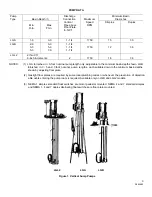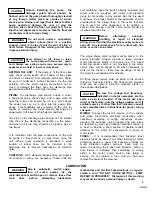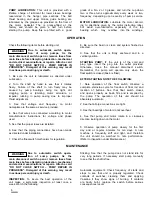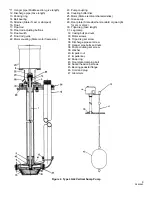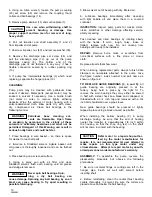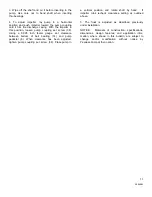
Motor: See that the motor comes up to speed
quickly and maintains constant rotation rate.
ROUTINE CARE:
General cleaning: Keep the interior and exterior of motor
and
automatic
apparatus
free
from
moisture,
oil and dirt.
Basin cleaning: Occasionally run the pump until the
basin is drained of water, open the electric circuit,
disconnect the discharge pipe at the union, (also, if
pump is of floor plate type, remove the anchor bolts)
and pull the pump out of the basin. Clean out sludge
or foreign matter accumulated in the basin and on
the strainer before returning the pump to service.
Lubricating: At regular intervals lubricate motor and
pump as directed under Lubrication.
Before attempting examination
or repairs to pump open the
disconnect switch to electric motor. This prevents
accidental running of pump motor. Starting motor
during examination or repair activities could damage
pump and may cause personal injury.
IF PUMP FAILS TO OPERATE:
1. Check fuses or thermal units, see if blown,
thrown, or loose. Before replacing or resetting be
sure the cause for the open circuit is determined and
corrected.
2. See if shaft rotates freely, try turning by hand.
3. See that switch contacts are not corroded,
shorted, or electrical service broken anywhere in the
circuit.
4. Check power supply and compare with motor
nameplate data.
5. Have motor windings ground tested for short.
IF PUMP IS NOISY:
1. If motor is noisy, check motor bearings for wear
or lack of lubrication.
2. If pump is noisy, check basin for presence of
foreign material, inspect bearings for wear, see if
strainer is clogged.
3. If the flexible coupling connection is noisy, see
that
coupling
is
not
binding
and
that
motor
alignment is correct.
4. Rotate pump by hand to see if impeller is rubbing.
IF PUMP OPERATES AT BLOW OR VARIABLE
SPEED:
1. See that switch contacts are not arcing.
2. Test for loose connections.
3. If motor is three phase, see that all phases are
“live.”
4. Be sure the shaft rotates, freely, try turning by
hand.
5. Test motor, see if partially grounded.
6. Test service for low voltage.
7. Be sure motor is wired for the voltage used.
IF PUMP OPERATES BUT FAILS TO EMPTY SUMP:
WARNING
1. See if strainer is clogged and basin dirty.
2. Check rotation of pump.
3. See if check valve in discharge line is stuck.
4. Check discharge head, see if beyond pump rating.
5. Check basin; see if inflow is excessive.
6. See if shaft is intact and if the impeller rotates.
Check the flexible coupling connection.
7. Check to see if pump is air bound.
DISASSEMBLY:
Disassemble the sump pump in the
following manner (see figure 2):
Tie the disconnect switch open
or remove fuses from lines before attempting to
remove pump from the basin. Attach a card “DO
NOT CLOSE SWITCH – PUMP REPAIR IN
PROGRESS.” Disregard of this warning may result
in fatal electrical shock.
WARNING
1. Break the electric service and remove the motor,
disengaging the coupling (22) by gently prying the
buffer disc (24) off the pins so that the disc comes
off with the motor.
Do not work under a suspended
object unless there is a positive
support under it to stop its fall in event of sling or
hoist failure.
WARNING
2. Disconnect the pump discharge at the union,
remove floor plate bolts, and puss the pump out of
the sump basin.
3. Remove the assembly.
7
2899982



